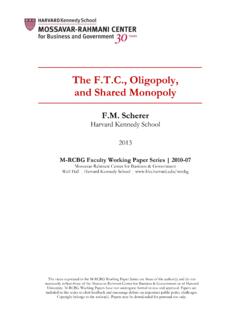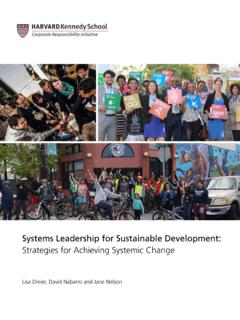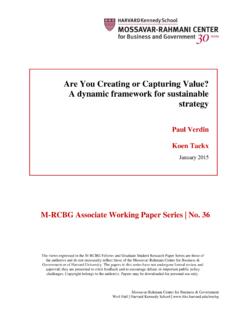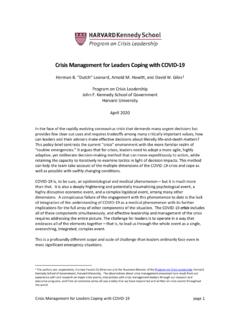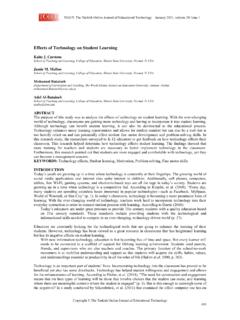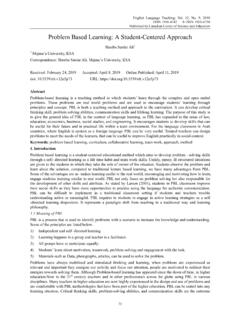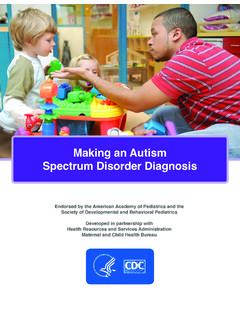Transcription of Using Small Groups to Engage Students and Deepen …
1 Using Small Groups to Engage Students and Deepen learning in New HKS Classrooms What is Small -group learning ? Small -group learning is a method that can supplement case discussions, lectures and other class formats. Students work together in Groups of typically 3-6 members, helping each other think critically, master course concepts, and apply them to real-world situations. Students are motivated toward a common goal and work together to support each other s learning . Small -group learning is different from working in teams, which typically involves longer periods of time, consistency of group membership, and more interdependence in completing the task.
2 (For more on Using student teams, see Teaching with Teams: An Annotated Compendium of Resources, ( login required). By contrast, Small -group learning tends to be more informal and brief, and can happen multiple times in one class session. Typically, Small -group work counts as part of the class participation grade. HKS new classrooms provide an exciting opportunity for active learning and instructional flexibility. The furniture layout in the cluster classrooms (Wexner 330 & 332, Rubenstein 304 & 306) enables seamless shifts from whole-class to Small -group discussions; cutting-edge technologies make thinking and learning visible through polling, wireless projection and report-outs, and enable guests from around the world to Engage with Students virtually.)
3 This guide offers strategies for making the most of student Small group work, featuring specific activities used by a range of HKS faculty and courses. Why use it? learning science research has shown that Small -group learning (when compared to competitive and individualistic learning ) improves academic achievement, relationships with classmates and faculty, and promotes psychological well-being. The following summarizes these benefits, drawn from a meta-analysis of Small -group learning in universities in The Journal on Excellence in College Teaching (Johnson et. al., 2014). Academic: Compared to competitive and individualistic learning , Students are better at solving problems and develop a deeper understanding of the material when working in Groups .
4 Regardless of subject, Students learn more and retain material longer in Small -group learning than when the same content is presented in other instructional practices. Attendance, efficiency, and persistence improve. Social: Students develop social and leadership skills, such as learning how to draw out reluctant speakers, handle people who dominate the conversation, and making sure that all members contribute. Students who process information and work together on a problem in Groups are also more committed to staying in school and are more likely to integrate across different ethnic, cultural, language, class, ability, and gender Groups .
5 Psychological: Small -group learning helps draw people out who normally would not participate in front of the whole class. It also promotes self-esteem as compared to competitive or individualistic learning . Sample Small -Group Exercises Below are some examples of brief Small -group activities that instructors can use at different points during class sessions, to complement a lecture or other formats, and Deepen understanding of the material. Turn-and-Talk: Pairs or trios briefly share responses to an instructor s prompt. The instructor then elicits responses from the whole class, calling on various Groups .
6 Think-Pair-Share: Individuals write in response to an instructor s prompt, then share those responses in pairs; the instructor then facilitates report-outs from some pairs. Peer Instruction: The instructor polls the class (Poll Everywhere or raise of hands) on a question; if responses are sufficiently divergent, Students talk with 1-2 peers about their responses, then instructor polls again. Jigsaw: Class is divided into several teams, with each team preparing separate but related assignments. When all team members are prepared, the class is re-divided into mixed Groups , with one member from each team in each group.
7 Each person in the group teaches the rest of the group what he/she knows, and the group then tackles an assignment that pulls all of the pieces together to form the full picture. Pro-Con-Caveat Grids: Students analyze a proposal or solution to a problem with a pro-con-caveat grid individually. They then come together in Small Groups to take the best ideas and form a more nuanced, complex grid. After teams complete the new grid, they pass it on to another team, where Students discuss what they agree and disagree with, what points they find interesting or surprising (Millis, 2014). Three-Step Interview: Students interview each other in pairs.
8 The pair links with another pair and the four-member team shares what insights they gleaned from the initial interviews. (Davidson et. al., 2014) The learning Process Instructors should be clear from the beginning that the class will involve Small -group work, and be explicit about how group work will help achieve course objectives ( , to practice interpersonal and organizational skills needed in real-world applications). For Students to learn how to work in Groups and develop skills on how to listen, provide feedback, evaluate assumptions and evidence, and draw out perspectives, one option is to have Groups assign roles to its members, such as facilitator , note-taker, timer, and reporter.
9 Students are more likely to discuss and interact if they are required to solve a multi-layered problem or make a decision based on research and analysis. Students are then more likely to learn that other members perspectives are valuable. Citations Davidson, N., Major, C. H., & Michaelsen, L. K. (2014). Small -group learning in higher education cooperative, collaborative, problem-based, and team-based learning : An introduction by the guest editors. Journal on Excellence in College Teaching, 25(3&4), 1-6. Johnson, D. W., Johnson, R. T., & Smith, K. A. (2014). Cooperative learning : Improving university instruction by basing practice on validated theory.
10 Journal on Excellence in College Teaching, 25(3&4), 85-118. Millis, B. J. (2014). Using cooperative structures to promote deep learning . Journal on Excellence in College Teaching, 25(3&4), 139-148. Additional Resources Effective Group Work in the College Classroom Instructors and Students share their experiences, and Nobel laureate Carl Wieman explains what the research suggests for best practices in implementing group activities. Examples include worksheets, whiteboard, and case studies. Group Work: Using Cooperative learning Groups Effectively - Vanderbilt Center for Teaching Includes sections on theoretical underpinnings and evidence of effectiveness for group work.
